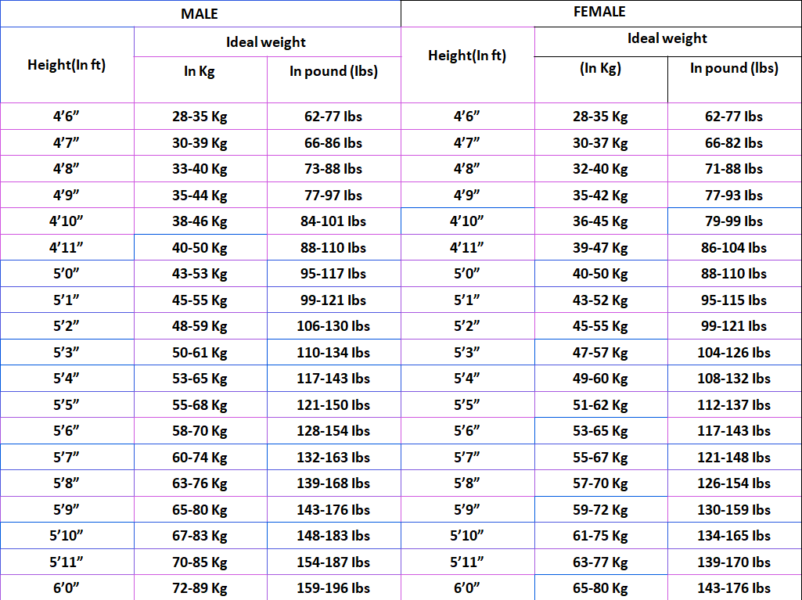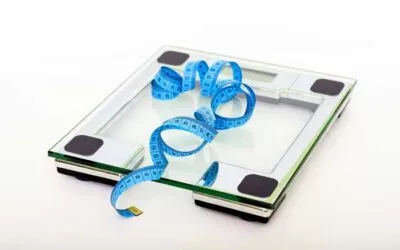A healthy range of weight that is supposed to be extremely beneficial for an individual. However, it’s altered by several factors such as sexual characteristics (man & women), physique, age, and grade of muscular expansion. So let us know in depth about Ideal Body Weight.
It is a tool which classify a person as “malnourished,” “standard weight,” “bulky,” or “overweight.”
Therefore, it does not have any accurate formula to find out ideal body weight. Even more persons are fit with variation of weights, sizes and shapes. Maintain a healthy routines and lifestyle will help you better than any figure on the scale.
First of all, it is important to find out the category of BMI Index in your weight range. It is one of the most standard method to evaluate an ideal weight range. We have a tables under, which assist you to figure out your BMI.
But before that let us know which theory asserts each individual has an ideal body weight.
Which Theory Asserts That Each Individual Has An Ideal Body Weight That Is Resistant To Change?
The theory that asserts each individual has an ideal body weight that is resistant to change is “The Set-Point Theory“.
Body Mass Index (BMI) Table.
Body Mass Index often known as BMI is used to determine the health of a person by a specific calculation of your body mass, to check whether the person is malnourished, over nourished or healthy.
It is basically predict, amount of body fat depends upon your height and weight.
BMI table range from low to high along with categories:-
Higher scale of number in BMI may upsurges your risk of many serious health issues, including:
- Heart related disease.
- High cholesterol.
- High blood pressure.
- Type 2 diabetes.
- Breathing difficulties.
- Gallstones.
BMI Range | Category |
Below 18.5 | Underweight |
18.5-24.9 | Normal Weight |
25.0- 29.9 | Pre-obesity |
30.0-34.9 | Obesity Class 1 |
35.0-39.9 | Obesity Class 2 |
Above 40 | Obesity Class 3 |
Check your BMI:
*Note– BMI numbers in this table range from 18.5 to 27 is given below. For the table consist numbers greater than 27, see the website of National Heart, Lung and Blood Institute.
| BMI (KG/M2) | Nutritional Status |
| <18.5 | Chronic energy deficiency |
| 18.5-23.0 | Normal |
| 23.0-27.0 | Overweight |
| >27.0 | Obesity |
We provide you chart where you can find out an ideal body weight chart for men and women in kg as well as you will find out how to calculate Ideal body weight in Pounds?
Ideal Body Weight Chart According To Weight Ranges by Age & Height.

Ideal Body Weight Chart for Children According to WHO.
Most of the parents considered a flabby baby is a good sign of health. But it is not true. Read the WHO’s report regarding child growth.
A normal teenager gains 2 kg in every single year between the age of 3 to 7 years and 3 kg per year after that, till the pubertal development begins.
Here is the table below where you can merely calculate your baby’s ideal body weight:-
| Age group | Weight |
| 0-3 Months | Gain of 175 g – 210 g per week |
| 5 Months | Double the Birth Weight |
| 6-12 Months | Gain of 400 g per month |
| 1 Year | 3 times the birth weight |
| 2 Years | 4 times the birth weight |
| 3 Years | 5 times the birth weight |
| 5 Years | 6 times the birth weight |
| 7 Years | 7 times the birth weight |
| 10 Years | 10 times the birth weight |
| Footnote. Parents must be focus on the endurance and activity, not on the weight. If your children is active and healthy, then there is nothing to worry regarding the weight gain. |
| Read Now: GOLO Diet: A Diet for Weight Loss. |
Difference Between Ideal Body Weight (IBW) and Body Mass Index (BMI).
| Ideal Body Weight (IBW) | Body Mass Index (BMI) |
| It define a healthy weight range which is supposed to be extremely beneficial for an individual. | BMI is used to determine the health of a person by a specific calculation of your body mass. |
| This is a tool which classify a person as underweight or overweight. | We can find out whether the person is malnourished, over nourished or healthy. |
| Altered by factors such as sexual characteristics (man & women), age, physique and grade of muscular expansion. | Simply measures according to height and weight. It does not account, where the weight comes from either of lean tissue or fat. |
| It does not have any limitations. | BMI have some limitations in case of Body builders, weight lifters, high performance athlete and Pregnant women. |
| Based on height and weight. So, it provide high accuracy and overall perception of the body. | It is an indicator of high body fat. Which use to determine the weight categories leads to health problems but it is not similar like diagnosis of the body. |
You may find out your ideal body weight by using this formula –
| For Men | Ideal Body Weight = 50 kg + 2.3 kg for each inch above 5 feet. |
| Women | Ideal Body Weight = 45.5 kg + 2.3 kg for each inch above 5 feet. |
What are Roughly Other Techniques to Determine Healthy Weight?
Apart from the above mentioned method some other procedures you can use such as –
- Body fat percentage.
- Waist to height ratio.
- Waist to hip ratio.
How Can You Manage Your Weight?
Regular workout plan along with balanced nutrition is the key which help you to maintain a healthy weight.
You may also note down these quick and effective tips:
Prefer Whole Foods.
Vegetables, Garden-fresh fruits, whole grains, low fat milk, protein and nuts are good preference.
You will find out these foods easily in your surroundings.
Focus on Regular Exercise.
Burning more calories is the main key to weight loss. You can burn lots of extra calories by doing regular exercise only for half an hour.
It will also protect you from several disease and boost your immunity such as walking, yoga, gym & running.
Complimentary Foods.
Sathu Maavu, Peach, Eggs, Dry fruits, Olive, Milk, Ragi, Sweet Potato, Cheese, Pear, Banana, Avacado.
| Footnote. Regular exercise along with whole foods is the key which help you to maintain a healthy weight. |
Frequently Asked Questions.
To find out a healthy weight of a person, at first you must find out the Body mass index (BMI), which is one of the effect ways to calculate an ideal body weight. If your BMI is between 18.5 to 24.9 that means you are in the normal weight range according to your height. If your result is under 18.5 then you are considered as underweight and between 25 to 29.9 means you are overweight.
Face weight or face fat shows ridiculous, so here are 12 effective ways through which you can easily lose your face fat;
Cut down refined or simple carbs and prefer whole grain.
Take adequate sleep.
Take facial exercises once a week.
Maintain your ideal body weight and body fat percentage.
Avoid excessive sugar.
Quit smoking.
Regular exercise.
Do Cardio to maintain a healthy weight and to lose body fat.
Drink plenty of Water.
Avoid Alcohol.
Limit your sodium intake.
Reduce stress.
According to the Centers for Disease Control and Prevention (CDC) an American women aged about 20 years and above, have 170.6 pounds (lbs) or 77.38 kg and an Indian women have 121.5 pounds (Ibs) or 55.1 kg according to their height. While these numbers may be differ according to the body structure.
The average weight of an American man who is 20 years old have 197.9 pounds or 89.7 kg and the average weight of an Indian men is 132.2 ls or 60 kg. This may be vary according to the body structure.
Make an aim for a sharp and long walk of 30-90 minutes in regular manner leads to weight loss. You should speed up your walking that you can reach to the “moderate intensity exercise zone”. In this process your heart rate will increase at about 60 to 70 percent. With this procedure you can lose your weight within a few months.
Bottom Line.
There are many different ways to compute the ideal body weight. But most of them have some marginal fault, particularly when done at home.
If you are tensed regarding your excessive weight, consult with your doctor for a physical checkup. Your doctor will help you to plan a balance diet chart to lose or gain weight.
With this tips start your journey today toward the healthy lifestyle and achieve your key of fitness by maintaining your ideal body weight.
+2 Sources
Freaktofit has strict sourcing guidelines and relies on peer-reviewed studies, educational research institutes, and medical organizations. We avoid using tertiary references. You can learn more about how we ensure our content is accurate and up-to-date by reading our editorial policy.
- Everything You Need to Know About Heart Disease; https://www.healthline.com/health/heart-disease#types-of-heart-disease
- WHO Child Growth Standards WHO Child Growth Standards; https://www.who.int/childgrowth/standards/Technical_report.pdf

 Workout
Workout
 Meditation
Meditation


 Stories
Stories


 Podcast
Podcast E-book
E-book















